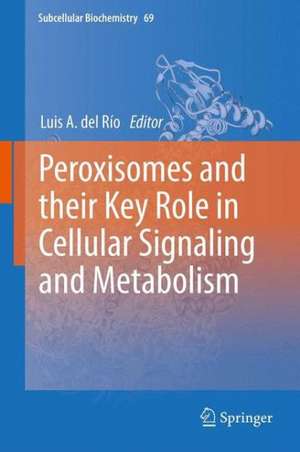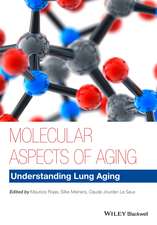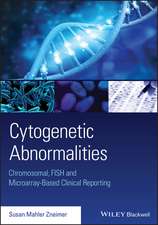Peroxisomes and their Key Role in Cellular Signaling and Metabolism: Subcellular Biochemistry, cartea 69
Editat de Luis A. del Ríoen Limba Engleză Hardback – 29 iul 2013
| Toate formatele și edițiile | Preț | Express |
|---|---|---|
| Paperback (1) | 1097.91 lei 6-8 săpt. | |
| SPRINGER NETHERLANDS – 5 aug 2015 | 1097.91 lei 6-8 săpt. | |
| Hardback (1) | 1111.26 lei 6-8 săpt. | |
| SPRINGER NETHERLANDS – 29 iul 2013 | 1111.26 lei 6-8 săpt. |
Din seria Subcellular Biochemistry
- 18%
 Preț: 948.79 lei
Preț: 948.79 lei - 5%
 Preț: 1456.88 lei
Preț: 1456.88 lei - 18%
 Preț: 1373.84 lei
Preț: 1373.84 lei - 18%
 Preț: 1243.78 lei
Preț: 1243.78 lei - 18%
 Preț: 2098.81 lei
Preț: 2098.81 lei - 18%
 Preț: 1122.10 lei
Preț: 1122.10 lei - 5%
 Preț: 1160.63 lei
Preț: 1160.63 lei - 18%
 Preț: 1396.26 lei
Preț: 1396.26 lei - 18%
 Preț: 1114.96 lei
Preț: 1114.96 lei - 18%
 Preț: 1224.68 lei
Preț: 1224.68 lei - 18%
 Preț: 951.29 lei
Preț: 951.29 lei - 18%
 Preț: 1227.99 lei
Preț: 1227.99 lei -
 Preț: 398.15 lei
Preț: 398.15 lei -
 Preț: 399.88 lei
Preț: 399.88 lei - 18%
 Preț: 1231.47 lei
Preț: 1231.47 lei - 18%
 Preț: 1230.35 lei
Preț: 1230.35 lei -
 Preț: 392.60 lei
Preț: 392.60 lei - 18%
 Preț: 1231.47 lei
Preț: 1231.47 lei - 15%
 Preț: 638.76 lei
Preț: 638.76 lei - 5%
 Preț: 656.26 lei
Preț: 656.26 lei -
 Preț: 389.49 lei
Preț: 389.49 lei - 5%
 Preț: 659.19 lei
Preț: 659.19 lei -
 Preț: 392.37 lei
Preț: 392.37 lei - 5%
 Preț: 662.09 lei
Preț: 662.09 lei -
 Preț: 395.09 lei
Preț: 395.09 lei - 5%
 Preț: 667.99 lei
Preț: 667.99 lei -
 Preț: 400.47 lei
Preț: 400.47 lei - 18%
 Preț: 1224.54 lei
Preț: 1224.54 lei - 15%
 Preț: 647.73 lei
Preț: 647.73 lei - 15%
 Preț: 646.75 lei
Preț: 646.75 lei - 5%
 Preț: 662.30 lei
Preț: 662.30 lei -
 Preț: 395.25 lei
Preț: 395.25 lei - 18%
 Preț: 1230.21 lei
Preț: 1230.21 lei - 18%
 Preț: 1231.95 lei
Preț: 1231.95 lei - 18%
 Preț: 964.54 lei
Preț: 964.54 lei
Preț: 1111.26 lei
Preț vechi: 1169.74 lei
-5% Nou
Puncte Express: 1667
Preț estimativ în valută:
212.69€ • 221.21$ • 178.24£
212.69€ • 221.21$ • 178.24£
Carte tipărită la comandă
Livrare economică 13-27 martie
Preluare comenzi: 021 569.72.76
Specificații
ISBN-13: 9789400768888
ISBN-10: 9400768885
Pagini: 364
Ilustrații: XII, 350 p.
Dimensiuni: 155 x 235 x 25 mm
Greutate: 0.84 kg
Ediția:2013
Editura: SPRINGER NETHERLANDS
Colecția Springer
Seria Subcellular Biochemistry
Locul publicării:Dordrecht, Netherlands
ISBN-10: 9400768885
Pagini: 364
Ilustrații: XII, 350 p.
Dimensiuni: 155 x 235 x 25 mm
Greutate: 0.84 kg
Ediția:2013
Editura: SPRINGER NETHERLANDS
Colecția Springer
Seria Subcellular Biochemistry
Locul publicării:Dordrecht, Netherlands
Public țintă
ResearchCuprins
Peroxisome interactions and cross-talk with other subcellular compartments in animal cells.- Peroxisomes in human health and disease: metabolic pathways, metabolite transport, interplay with other organelles and signal transduction.- Aging, age-related diseases and peroxisomes.- Peroxisomes and the antiviral responses of mammalian cells.- Peroxisome proliferator-activated receptor-α signaling in hepatocarcinogenesis.- Involvement of human peroxisomes in biosynthesis and signaling of steroid and peptide hormones.- Peroxisome Ca2+ homeostasis in animal and plant cells.- The versatility of peroxisome function in filamentous fungi.- Essential roles of peroxisomally produced and metabolized biomolecules in regulating yeast longevity.- Metabolite transporters of the plant peroxisomal membrane - known and unknown.- Peroxisomes and photomorphogenesis.- Biosynthesis of vitamin K1 (phylloquinone) by plant peroxisomes and its integration into signaling molecule synthesis pathways.- Role of peroxisomes as a source of reactive oxygen species (ROS) signaling molecules.- Peroxisomes as a source of auxin signaling molecules.- Peroxisomes as cell generators of reactive nitrogen species (RNS) signal molecules.- Role of plant peroxisomes in the production of jasmonic acid-based signals.- Role of plant peroxisomes in protection against herbivores.- Function of Peroxisomes in Plant-Pathogen Interactions.
Textul de pe ultima copertă
Peroxisomes are a class of ubiquitous and dynamic single membrane-bounded cell organelles, devoid of DNA, with an essentially oxidative type of metabolism. Today it is known that fatty acid β-oxidation is a general feature of virtually all types of peroxisomes, but in higher eukaryotes, including humans, peroxisomes catalyze ether phospholipids biosynthesis, fatty acid α-oxidation, and glyoxylate detoxification, and in humans peroxisomes are associated with several important genetic diseases. Among the different new roles for human peroxisomes discovered in recent years are antiviral innate immunity, peptide hormone metabolism, brain aging and Alzheimer’s disease, and age-related diseases. In fungi, new findings have broadened the number of secondary metabolites that are synthesized in peroxisomes, such as antibiotics and several toxins, and have evidenced their involvement in biotin biosynthesis, fungal development and plant pathogenesis. In plants, peroxisomes carry out different functions, apart from fatty acid β-oxidation, mainly including photorespiration, metabolism of reactive oxygen, nitrogen and sulfur species, photomorphogenesis, biosynthesis of phytohormones, senescence, and defense against pathogens and hervibores.
Two important characteristics of peroxisomes are their metabolic plasticity and capacity of sharing metabolic pathways with other cell compartments. In recent years, a function for peroxisomes as key centers of the cellular-signaling apparatus which could influence the regulatory network of the cell has been postulated. The diverse key physiological functions that have been demonstrated for peroxisomes from differentorigins strongly indicate the interest of studying the role of peroxisomes as a cellular source of different signaling molecules. This book presents recent advances in the function and metabolism of peroxisomes from human, animal, fungal and plant origin and their metabolic interconnection with other cell compartments, showing the central role played by peroxisomes as cell generators of different signaling molecules involved in distinct processes of high physiological importance.
Two important characteristics of peroxisomes are their metabolic plasticity and capacity of sharing metabolic pathways with other cell compartments. In recent years, a function for peroxisomes as key centers of the cellular-signaling apparatus which could influence the regulatory network of the cell has been postulated. The diverse key physiological functions that have been demonstrated for peroxisomes from differentorigins strongly indicate the interest of studying the role of peroxisomes as a cellular source of different signaling molecules. This book presents recent advances in the function and metabolism of peroxisomes from human, animal, fungal and plant origin and their metabolic interconnection with other cell compartments, showing the central role played by peroxisomes as cell generators of different signaling molecules involved in distinct processes of high physiological importance.
Caracteristici
Describes the central role played in cellular signaling by peroxisomes from different origins Provides an up-to-date information on the function and metabolism of peroxisomes from human, animal, fungal and plant origin Provides updated information on the metabolic interconnection and cross-talk of peroxisomes with other cell compartments Describes the key cellular function played by peroxisomes as cell generators of important signaling molecules Covers the role played by peroxisomes in human health, aging and disease









